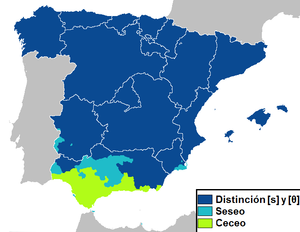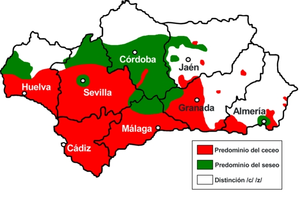Ceceo and Seseo

Ceceo and Seseo are two competing variants of the articulation of sibilants (voiceless s-sounds) in the pronunciation of the Spanish language . The phonemes / s / and / θ / articulated in the standard variety as voiceless alveolar fricative [ s ] or voiceless dental fricative [ θ ] coincide in the Ceceo to a common phoneme / θ /, in the Seseo to / s /.
Basics
In general, continental Spanish the grapheme ⟨ s ⟩ on one side and ⟨ for ⟩ or ⟨ c ⟩ pronounced differently on the other side: the ⟨ s ⟩ as / s / and ⟨ for ⟩ - like the ⟨ c ⟩ before ⟨ e ⟩ and above ⟨ i ⟩ - as / θ /.
In Ceceo, all these sounds are pronounced as / θ / (similar to the unvoiced English th sound ); in Seseo, on the other hand, they are pronounced as / s /.
Common to the phenomena Ceceo and seseo that the distinctiveness of minimal pairs as ⟨ casa ⟩ (German "House") and ⟨ caza ⟩ ( "Hunting") is omitted. In simple terms, can in speakers that use the Ceceo or seseo, can not be determined whether the speaker "house" ( casa ) or "hunting" ( caza ) says.
Both phenomena can be found both in Spain and in Latin America. While Seseo can be regarded as the Latin American standard pronunciation and dominates throughout Hispanic America , in Spain, in addition to the continental standard pronunciation, which is called Distinción and differentiates the two sounds, Seseo and Ceceo are mainly used in the south. The occurrence and distribution of the phenomenon are historically associated with the so-called Castilian desonorization , a sound change among the Sibilants of Spanish, which took place around the same time as the colonization of America and in the course of which the distinction between voiced and unvoiced phonemes of this sound group in the The Castilian-speaking area generally disappeared around the 17th century.
While the Seseo is accepted as an urban pronunciation variant of the Spanish south, the more rural-rural perceived Ceceo in Spain "has always had a flaw of the rustic and vulgar" (Hugo Kubarth).
Ceceo

The ceceo (phoneme collision in favor of the / θ /) is assigned to the Andalusian dialect and can be found in circumscribed areas, especially in southern Andalusia , which are also known as zona ceceante . These include a wide strip along the southern coast of Spain from Huelva to just outside Almería and the rural areas of the province of Seville (excluding the city of Seville , where urban Seseo reigns).
In Latin America, too, there are isolated Ceceo regions in Puerto Rico , Colombia , Central America and Argentina, and possibly Chile .
Seseo
The seseo (phoneme collision in favor of the / s /) prevails in central Andalusia and in parts of Extremadura as well as in most of southern Spanish urban centers, as well as in the Canary Islands and in all Latin American varieties of the Spanish language. That is why the Seseo is sometimes described as a "pan-Atlantic phenomenon", which connects the language varieties from southern Spain on both sides of the ocean and documents their common origin.
Historically, the urban dialect of Seville (including Seseo) is commonly considered to be one of the main sources of Spanish spoken in Latin America and the Canary Islands. However, this hypothesis is viewed by some researchers as too speculative and based on the written evidence that Seseo was more widely used in Spanish in the 16th century than in Andalusia, so that the common doctrine that the Andalusian dialect spread in Latin America is not seems completely secure. Amado Alonso already denied the Andalusian origin of the Latin American Seseo and considered (like Rafael Lapesa similarly ) an independent further development of the pronunciation in the overseas territories parallel to the motherland as more likely; on the other hand, other researchers have vehemently defended the historical connection between Seseo and Seville.
On the Spanish mainland there are also variants of Seseo outside of Andalusia and Extremadura, which, however, differ in articulation from the Andalusian-extreme Seseo: The Basque and Valencian Seseo are considered to be apicoalveolar (tip of the tongue on the upper dome, sounds slightly lisped and is therefore similar stronger than the Ceceo), while the southern Spanish Seseo is described as predorsal (articulated on the back of the tongue).
further reading
- Jens Lüdtke : Nebrija and the scribes: ceceo / seseo in the early expansion of overseas Spanish. In: Hans Helmut Christmann, Richard Baum: Lingua et traditio: History of linguistics and modern philologies: Festschrift for Hans Helmut Christmann on his 65th birthday. Gunter Narr Verlag, Tübingen 1994, ISBN 3-8233-4137-5 , pp. 29-41 ( preview in Google book search).
Individual evidence
- ↑ Jens Lüdtke: Nebrija and the scribes: ceceo / seseo in the early expansion of overseas Spanish. In: Lingua et traditio. Festschrift for Hans Helmut Christmann. Tübingen 1994, pp. 37-40.
- ↑ a b c d e Barbara Schäfer-Prieß (Institute for Romance Philology, LMU ): phonetic differences between European and American Spanish (script “HS Variety Linguistics Spanish / Portuguese”, winter semester 2010/2011).
- ↑ a b c Rafael Lapesa : Sobre el Ceceo y el Seseo en Hispanoamérica. In: Revista Iberoamericana 21 (1956), pp. 409-416 (here: 410 f.).
- ^ Hugo Kubarth: Spanish phonetics and phonology: segments - syllables - sentence melodies . Verlag Peter Lang, 2009. ISBN 3631595271 ; P. 105 f.
- ↑ Thorsten Roelcke: Variation Typology: A typological handbook of European languages in the past and present . Walter de Gruyter, 2003. ISBN 3110160838 ; P. 466.
- ^ Alfredo I. Alvarez Menéndez: Hablar en español: la cortesía verbal, la pronunciación estándar del español, las formas de expresión oral. Universidad de Oviedo, 2005. ISBN 8484591905 ; P. 134.
- ↑ Javier Medina López: Dialectología histórica del español de Canarias: Hacia una configuración del seseo en la obra de JB Poggio Monteverde (p. XVII) . In: Manuel Almeida, Ramón Trujillo, Josefa Dorta: Contribuciones al estudio de la lingüística hispánica: Homenaje al profesor Ramón Trujillo. Pp. 333-346. Editorial Montesinos, 1997. ISBN 8489354413 ; P. 334.
- ↑ a b Vidal Lamíquiz: Lengua española: método y estructuras lingüísticas . Editorial Ariel, 2004. ISBN 8434482029 , pp. 103 f.
- ↑ Jens Lüdtke: Nebrija and the scribes: ceceo / seseo in the early expansion of overseas Spanish. In: Lingua et traditio. Festschrift for Hans Helmut Christmann. Tübingen 1994, p. 35.
- ↑ Amado Alonso ( Harvard ): Historia del ceceo y seseo españoles. In: Boletín del Instituto Caro y Cuervo , Vol. VII (Bogotá 1951), pp. 111-200 (cf. Zsfg. P. 200).
- ^ Juan Antonio Frago Gracia ( Seville ): El Seseo entre Andalucía y América. ( Memento of the original from June 12, 2017 in the Internet Archive ) Info: The archive link was inserted automatically and has not yet been checked. Please check the original and archive link according to the instructions and then remove this notice. In: Revista de Filología Española 69 (1989), pp. 277-310.